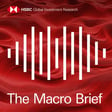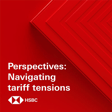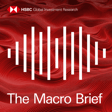Become a Creator today!Start creating today - Share your story with the world!
Start for free
00:00:00
00:00:01

ECB reaction, EM update, China’s demographics - HSBC Global Research
Simon Wells outlines the key takeaways from the ECB’s latest meeting, Murat Ulgen explains why Europe could be the next catalyst for EM assets and James Pomeroy assesses the demographic implications of China’s shift to a three-child policy. Disclaimer
To stay connected and to access free to view reports and videos from HSBC Global Research click here
Hosted on Acast. See acast.com/privacy for more information.
Transcript
Introduction to Global Banking and Markets
00:00:00
Speaker
This is HSBC Global Viewpoint, your window into the thinking, trends and issues shaping global banking and markets.
00:00:09
Speaker
Join us as we hear from industry leaders and HSBC experts on the latest insights and opportunities for your business.
00:00:17
Speaker
Thank you for listening.
Macro Viewpoint: Global Economy and Markets
00:00:26
Speaker
Hello and welcome to the Macro Viewpoint from HSBC Global Research, our weekly podcast featuring the views of leading HSBC analysts on the outlook for the global economy and markets.
00:00:36
Speaker
I'm Piers Butler and I'm joined by Chris Brown-Humes.
ECB Meeting: Impact on Europe and EM Assets
00:00:38
Speaker
Hi Piers, with the COVID-19 picture improving across Europe, we get the key takeaways from the latest ECB meeting with Simon Wells, Chief European Economist.
00:00:48
Speaker
Maret Ulgan, Global Head of Emerging Market Research, explains why Europe's recovery, not the US, could be a surprising catalyst for EM assets.
00:00:57
Speaker
And James Pomeroy, Global Economist, looks at what Beijing's shift to a three-child policy could mean for China's population challenges.
00:01:05
Speaker
This podcast was recorded on Thursday the 10th of June 2021.
00:01:08
Speaker
Our full disclosures and disclaimers can be found in the link attached to this podcast.com.
00:01:18
Speaker
Here in Europe, the ECB has just held its latest meeting, with the focus this month being the outlook for the bank's emergency bond-buying programme.
00:01:25
Speaker
Let's get the details from Simon Wells, Chief European Economist.
00:01:28
Speaker
So, Simon, there were some expectations going into the ECB meeting that they might start to taper their asset purchases.
00:01:34
Speaker
What did they decide to do?
00:01:36
Speaker
Well, there was some expectation a few weeks ago.
00:01:39
Speaker
This was going to be a key meeting where they revisited the decision made in March to conduct asset purchases at a significantly higher pace.
00:01:47
Speaker
I think perhaps going into the meeting, those expectations had come off a little.
00:01:52
Speaker
And indeed, in the event, the governing council decided to maintain pandemic emergency purchase programme purchases at a significantly higher pace for another quarter.
00:02:04
Speaker
So there was no tapering.
00:02:07
Speaker
And similarly, there was no changes in any other policy instruments or the statement.
00:02:11
Speaker
And Christine Lagarde said at the press conference that what had been required this time was a steady hand on policy.
00:02:19
Speaker
And what were the reasons then you think that they stayed with things as they are?
00:02:22
Speaker
Well, I think, first of all, had they tapered now, there would have been a risk of a further tightening in financial conditions, which is something the ECB has pledged to prevent.
00:02:33
Speaker
It might also have undermined fiscal support, particularly for the most indebted and high deficit countries if the ECB were to scale back borrowing.
00:02:44
Speaker
And of course, the medium term inflation forecast of the ECB is still well below target.
00:02:51
Speaker
So you put all that together.
00:02:52
Speaker
And despite a stronger recovery, it clearly concluded the steady hand was the right approach in June.
Fiscal Stimulus and Inflation Differences: Europe vs. US
00:02:59
Speaker
That's an interesting point about inflation, because as we know, inflation is surging in the US.
00:03:04
Speaker
Why is it so much more subdued in Europe?
00:03:06
Speaker
Well, inflation is rising in Europe, of course, and there are some common factors there.
00:03:10
Speaker
Supply disruption, input costs are rising in Europe very rapidly, as they are in the United States.
00:03:17
Speaker
And similarly, given the improved COVID situation in Europe, demand is starting to pick up as economies unlock.
00:03:26
Speaker
I think the major difference is in the size and nature of fiscal stimulus.
00:03:31
Speaker
The US stimulus has checks going directly to households, which are increasing spending power.
00:03:38
Speaker
By contrast, the eurozone fiscal stimulus is smaller, but more focused on investment and in any case is going to ramp up more next year and have a bigger impact on growth next year than it does this year.
00:03:52
Speaker
We also got some new ECB economic forecast today.
00:03:55
Speaker
Were there any surprises there?
00:03:57
Speaker
There were some pretty big revisions to growth, actually, Chris.
00:04:00
Speaker
2021, 2022 were both revised up 0.6 percentage points.
00:04:01
Speaker
So we now have 4.6% growth this year and 4.7% next year projected by the ECB.
00:04:12
Speaker
2023 was unchanged at 2.1%, but this still, of course, implies a faster recovery and importantly, considerably less lost output at the end of the ECB's forecast.
00:04:23
Speaker
And it has changed its balance of risk to be balanced around these higher projections, whereas previously risks had been skewed to the downside.
00:04:33
Speaker
In terms of inflation, as you might have expected, given our previous discussion, near term inflation was was revised up.
00:04:40
Speaker
But perhaps more significantly, the ECB nudged up by point one, its forecast for its measure of core inflation.
00:04:49
Speaker
And that reflects a judgment of less economic slack as a result of this faster growth
ECB Policy and Future Projections
00:04:54
Speaker
recovery.
00:04:54
Speaker
So finally, Simon, where does the ECB go from here?
00:04:57
Speaker
Well, Christine Lagarde calls it a steady hand on policy, but I think it's probably the line of least resistance, given the hurdle for policy action in either direction.
00:05:07
Speaker
On the one hand, tighter financial conditions and a still sub-target inflation forecast.
00:05:12
Speaker
might point to more policy easing.
00:05:15
Speaker
But the ECB doesn't want to do this because it would be worried about having to increase its PEP envelope or run into political or legal constraints.
00:05:25
Speaker
And so the hurdle for further easing is pretty high.
00:05:28
Speaker
On the other hand, with the economy recovering more sharply, there's arguably less need for the emergency policy settings.
00:05:34
Speaker
And given some of the constraints and concerns about balance sheet expansion, it's clear that some on the governing council want to do less.
00:05:41
Speaker
But given also the need to offer fiscal support, given that inflation forecast, the hurdle for tapering is clearly quite high as well.
00:05:52
Speaker
So for now, the ECB perhaps does it best when it does nothing at all, but it can't do that forever with the PEP programme scheduled to expire next March.
00:06:02
Speaker
We think it will want to avoid a cliff edge in purchases, not least to offer support for governments fiscally.
00:06:11
Speaker
And we think it will revert to its normal asset purchase program, perhaps a more flexible version and upping the monthly purchase rate, possibly from 20 billion to 40 billion per month.
00:06:23
Speaker
As for the June meeting, though, it was a case of no taper and no tantrums.
00:06:28
Speaker
That's great, Simon.
00:06:29
Speaker
Thank you very much for your time today.
00:06:31
Speaker
Thank you.
Challenges in Emerging Markets Due to COVID-19
00:06:35
Speaker
It's been a challenging start to the year for emerging markets, which have been hampered by continued COVID-19 headwinds.
00:06:41
Speaker
And with EM assets underperforming versus developed markets on a relative basis, where do we go from here?
00:06:47
Speaker
Murad Olgen is our global head of emerging markets research.
00:06:50
Speaker
Murat, welcome to the podcast.
00:06:52
Speaker
Thank you very much.
00:06:53
Speaker
So Murat, you've just published your latest update on global emerging markets.
00:06:57
Speaker
And clearly, investors have been very focused on very strong recovery in the US and some of the inflation expectations.
00:07:06
Speaker
What's the impact on emerging markets from this?
00:07:08
Speaker
That's very true.
00:07:09
Speaker
I mean, there's a lot of focus on the US economy and its inflation dynamics.
00:07:13
Speaker
And also the global reflation narrative since the beginning of the year has moved very swiftly towards emphasizing inflation rather than growth.
00:07:22
Speaker
And we sort of spent most of the first quarter to price in the data volatility for the rest of the year.
00:07:29
Speaker
And in the meantime, global upturn seems more sequenced than synchronized.
00:07:34
Speaker
So this backdrop generates some mixed blessings for emerging markets.
00:07:38
Speaker
given that EM, excluding Asia, is an underperformer in recovery.
00:07:42
Speaker
There are various reasons for that, like COVID-19 headwind still there in certain parts, disappointing vaccination performance and lack of expansionary policy space.
00:07:51
Speaker
So a relatively mixed outlook, but still the growth-sensitive assets have done relatively well so far this year.
00:07:59
Speaker
But overall, EM actually has underperformed EM.
00:08:02
Speaker
Now, you say that your models are telling you to maybe take the focus away from the US and look elsewhere.
00:08:08
Speaker
Where would that be?
00:08:09
Speaker
Correct.
00:08:10
Speaker
So we asked ourselves the question, what's next for EM?
00:08:13
Speaker
And to find out, we actually updated our models from last year that looked at drivers of EM returns.
00:08:20
Speaker
But this time we split the global factors into two regions, the US and the Eurozone.
00:08:25
Speaker
And as opposed to the US, Eurozone's stronger economic activity is actually having pretty positive impact on emerging markets and also loose financial conditions in Eurozone is also positive for emerging markets.
00:08:37
Speaker
That probably reflects Eurozone's role as the largest trading partner and capital provider for emerging markets.
00:08:46
Speaker
And also Europe domiciled funds are pretty big investors in EM as well.
00:08:51
Speaker
Overall, any changes to your outlook for emerging markets?
00:08:55
Speaker
Not really.
00:08:56
Speaker
We've been recommending growth-sensitive stories since the beginning of the year.
00:09:00
Speaker
And in the second quarter, we moved our focus more to commodity narrative, commodity stories.
00:09:06
Speaker
We still stick to our guns and we still believe there are opportunities in more growth-sensitive assets and commodity-linked stories in particular.
00:09:15
Speaker
All right.
00:09:15
Speaker
Thank you very much.
00:09:16
Speaker
Thanks for having me.
China's Demographic Policy Changes
00:09:20
Speaker
Now, we finish up this week in China, where President Xi Jinping has just approved a policy to allow couples to have up to three children instead of two.
00:09:28
Speaker
So what impact will this relaxation have on China's demographics?
00:09:31
Speaker
Let's hear from economist James Pomeroy, who's one of our global coordinators of demographics research.
00:09:37
Speaker
James, it wasn't that long ago that China only had a one-child policy.
00:09:40
Speaker
So why are we seeing this new change?
00:09:42
Speaker
So a couple of things have happened in China.
00:09:44
Speaker
Firstly, you've had the latest census showed a big drop in the birth rate over the course of the last decade.
00:09:50
Speaker
But also over the course of the past year, things may have got even worse given the pandemic and the drop in births.
00:09:57
Speaker
in China.
00:09:57
Speaker
So clearly, Beijing is a little bit concerned about some of the demographic projections for China, both in terms of total population and in working age population in the coming years.
00:10:08
Speaker
So what impact is this likely to have on the country's demographics?
00:10:11
Speaker
So there's two
00:10:11
Speaker
to that question, Chris.
00:10:13
Speaker
Firstly, we have to think about is this likely to mean we get an upturn in the fertility rate?
00:10:18
Speaker
Now, we don't think that is necessarily likely, partly because of looking at other parts of Asia.
00:10:24
Speaker
You can see in many places you have much lower fertility rates, so that suggests that things could drop even further.
00:10:31
Speaker
But equally in China itself, the fertility rate has been running well below two, even when couples can have two children.
00:10:37
Speaker
So it seems unlikely that this is the policy that's been holding that back.
00:10:41
Speaker
It's much more likely there are economic concerns, particularly for a younger generation and social change in terms of the number of children that couples are choosing to have.
00:10:50
Speaker
And those trends are unlikely to be changed by this policy move.
00:10:55
Speaker
But also it's important to remember that a lot of the demographic projections are using what's almost already happened in terms of birth rates.
00:11:03
Speaker
So if you think about the working age population in China, that's not going to be affected until maybe 20, 30 years down the line based on any policy change.
00:11:12
Speaker
And if you look at what's already in those projections, it's quite likely that the working age population in China drops by about 100 million people by the time we get to 2040.
00:11:21
Speaker
And if the fertility rate stays low, which we think it will, that could mean a further 100 million fewer workers in China by the time you get to 2050.
00:11:29
Speaker
So it seems unlikely these fertility rates do rise.
00:11:33
Speaker
But even if they do, you wouldn't really notice the impact for another 20 years or so.
00:11:37
Speaker
So what's that going to mean for Chinese growth?
00:11:39
Speaker
Well, you look at this and you think that's bad news because clearly you've got a shrinking working age population.
00:11:45
Speaker
That's likely to mean a drag to potential growth.
00:11:48
Speaker
But it is important to stress there are a lot of offsetting factors, particularly in terms of the productivity of that workforce.
00:11:55
Speaker
and which can continue to be improved, notably through continued urbanization.
00:11:59
Speaker
There's still a lot of that to run in China.
00:12:02
Speaker
But most importantly, in terms of the skills of the labor market, a lot better education rates, more people going to university, improvements in technology, all of those things should help to improve labor productivity.
00:12:14
Speaker
And this is why we still think that China's potential growth rate can stay above six and a half
Conclusion and HSBC Services Information
00:12:19
Speaker
percent.
00:12:19
Speaker
James, that's a great summary.
00:12:21
Speaker
Thank you very much for your time today.
00:12:22
Speaker
Thank you.
00:12:24
Speaker
That's it for this week.
00:12:25
Speaker
Thank you to our guests, Simon Wells, Meret Olgan, and James Pomeroy.
00:12:29
Speaker
From Piers and me, thanks very much for listening.
00:12:31
Speaker
We'll be back again next week.
00:12:40
Speaker
Thank you for listening today.
00:12:41
Speaker
This has been HSBC Global Viewpoint, Banking and Markets.
00:12:46
Speaker
For more information about anything you heard in this podcast or to learn about HSBC's global services and offerings, please visit gbm.hsbc.com.

















